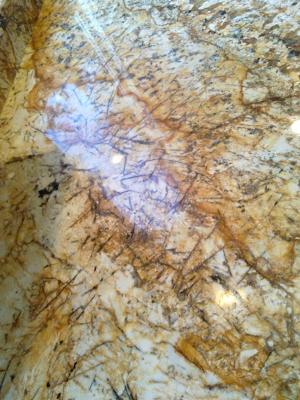New Kitchen Counter Isn't Smooth After Install
QUESTION:
We just had new granite kitchen countertops installed, using a high-movement stone with lots of veins and embedded crystals.The sample we picked was smooth as glass in the showroom (picture attached). But our granite countertops are not smooth after install.
They will snag paper towels when wiping and I can feel the transitions from the main material to some of the veins with my fingernails.
I asked the installer about this, and first he told me that's just how this particular granite is.
When I pressed him on the store sample being different, he said it could be some kind of epoxy residue from the factory (?) and took a razor blade to scrape the counter.
This did scrape off some kind of whitish material (and also left a light scratch in one area).
Then he said it still needed to be sealed, put on the sealer, and told us not to mess with it for 8 hours.
It's been 6 hours now, and the countertop surface feels kind of "plastic" when touching, but it's still not smooth everywhere.
I feel cheated - are we being blown off by this guy?
ANSWER:
The shiny smooth surface of the granite slab you saw in the showroom is exactly how a properly polished granite countertop should be.People sometimes complain of a gritty or rough granite surface after a new granite kitchen countertop installation but your issue seems to be of a different nature.
And just FYI... no chemical or sealer makes the countertop smooth or shiny. The "polish" comes from intense friction and abrasion on big machines at the factory.
How a granite sealer works is to slow down the rate of liquid absorption to help prevent staining.
Applying a sealer is not what makes the surface shiny or polished.
Many stone salespeople and installers are misinformed and think applying a granite sealer solves nearly any problem you may encounter.
And much like a doctor prescribing antibiotics for a cold (colds are viruses.... antibiotics don't work) he just "did something" to make it seem like he was solving a problem.
What's worse
You don't leave it on the surface for hours or even let it dry.
In fact, a granite sealer should not be left on the surface for more than 10 minutes in most cases and then wiped completely dry.
And 10 minutes is a really long time. Most often the sealer only needs to dwell for 2-5 minutes.
Thus, in addition to the existing issues you probably now have granite sealer stuck to the countertop surface... it should only be below the surface in the pores.
You may try these steps for removing sealer residue and see if that helps.
Most likely what occurred is that picked out a color via a sample and then the installer purchased a cheap low-grade version of that granite variety.
Something could be on the surface... like a resin, or sealer residue.
It may be that it was sealed prior to installation and the whitish substance scraped off was sealer residue.
Then he applied a sealer a second time and that may have made it worse.
Or a resin is often legitimately used to fill voids, etc., but it is applied prior to polishing and absorbs into the pores... does not sit on the surface.
The long and short is that you should have got the exact slab you picked out at the warehouse.
Picking out the exact granite slab that you want to install is the only acceptable way to purchase granite or any stone.
Choosing granite colors via a showroom sample is a gamble.
Why?
Because granite slabs and natural stone are "natural" products meaning there isn't any strict consistency from one slab to the next even among the same colors.
Now, most slabs of the same color will be similar, but you can certainly get an extreme difference in characteristics and quality, color shade, and pattern.
And if you entrusted your installer to pick out the slab, then at least you can hold him accountable to the fact that you chose a sample that was perfectly polished and that is what you expected.
Comments for New Kitchen Counter Isn't Smooth After Install
|
||
|
||
|
||
|
||
|
||
|
||
|
||
|
||
|
||
|
||
|
||
|
||
|
||
|
||
|
||
|
||
|
||
|
||
|
||
|
||
|
||
|
||
|
||
|
||
|
||
|
||
|
||
|
||
|
||
|
||
|
||
|
||




